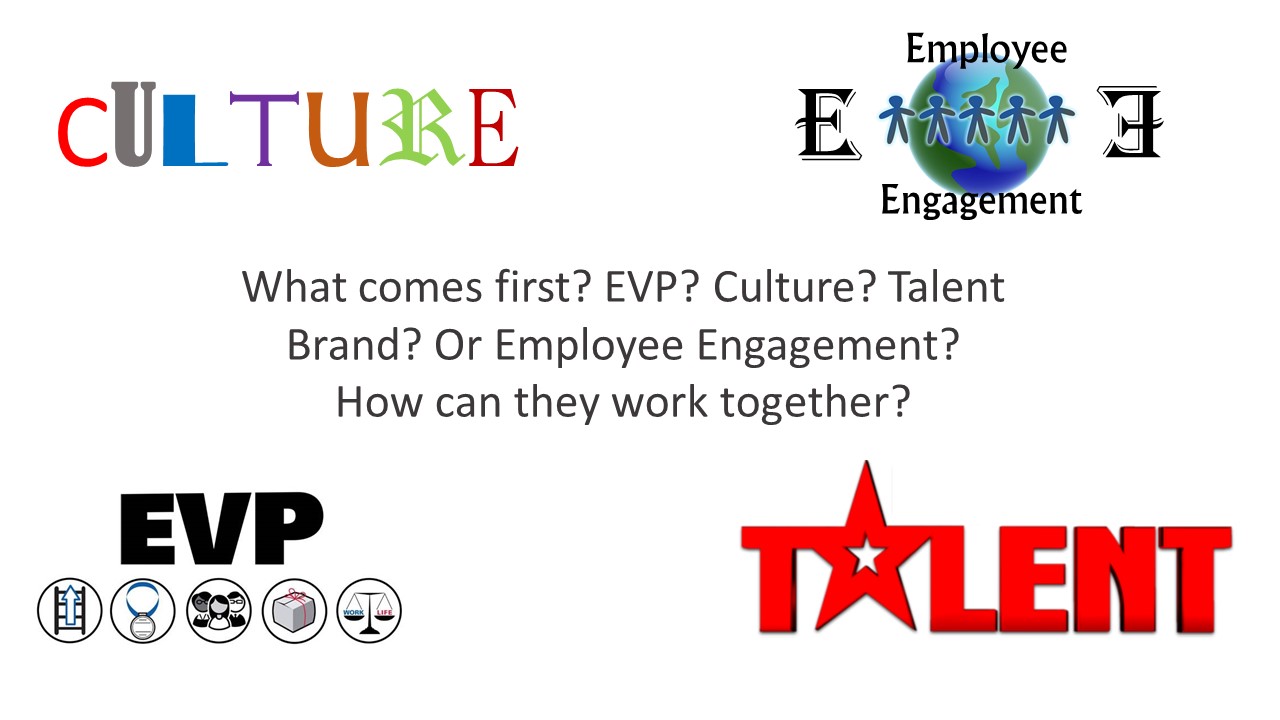What comes first? EVP? Culture? Talent Brand? Or Employee Engagement - How can they all work together?

In nearly every client interaction, the topic of competing messages and alignment occurs. What communication message takes precedence? How does a company communicate to its employees without creating confusion? How does a company communicate with one voice, tone and manner with a personality that is consistent across the organization?
What often happens, in a siloed organization, are competing internal initiatives that are created by individuals who rarely interact with their peers in HR, marketing and talent development. Sometimes communication coordination falls upon the internal communications professional who has the responsibility to sort out all the initiatives on their own but often lacks the authority and who is accountable to several stakeholders. It gets even more complicated when regions and different business units are thrown into the mix. The results are communication chaos, employee who tune out, ignored communication that can help them be more engaged and do their jobs with greater enthusiasm and productivity.
Here are Inward’s prescription on overcoming competing messages, communication tactics and the alignment dilemma.
PURPOSE: It all starts with a clarity of purpose. A clear statement from senior management to convey why the company is in business and what it hopes to achieve for employees, customers and shareholders.
PLAN HOLISTICALLY and SEQUENTIALLY: To address this challenge companies must plan holistically and sequentially and establish a complementary strategic and communications plan with multiple internal stakeholders who are collaborative, giving and consensus driven.
STEERING COMMITTEE and CROSS FUNCTIONAL TEAMS: Establish a group of people from various departments and functions, such as HR, marketing, corporate communications to function as a steering committee who can set goals and direction, provide input, budget and resources to ensure coordination of messages.
COMMUNICATIONS AUDIT OF MESSAGES: Take a step back to discover and review all internal communication initiatives and drill down to understand the individual meanings/intent of the initiative. Examine individual statements, make comparisons and determine whether the messages compete with one another. If they compete, find a way to resolve the conflict. Examine the individual messages as if they were puzzle pieces. Create core themes that are complementary with substantiation and rationale for inclusion and that support the company’s purpose. Mission and values.
Examine creative themes, tone and manner and personality traits. Discover whether they send mixed messages and compete with one another. Too often, organizations are afflicted by Icon/logo and tag line overkill and fatigue.
MESSAGE ARCHITECTURE: Once the audit is complete and the core message requirements are identified, go through a message laddering exercise. Explain in pedestrian terms, why it is important for the company, Second, why it is important for employees to understand and embrace the idea to help perform their job better and improve their life. Third, explain what new behaviors are required by individual employees that will help realize the company overall goals. Summarize the message laddering exercise and attempt to create a simple, easy to comprehend elevator pitch that brings all the elements together.
MESSAGE AND TACTICAL ALIGNMENT: After understanding the results from the audit and message architecture process the steering committee and cross functional team can collaborate to address their specific initiatives such as EVP, talent brand, or employee engagement. The key goal of this team becomes common ”aligned messages” with slight differing nuances and emphasis as needed, “consistent creative imagery” and an aligned “tactical executed communications plan” that educates, motivates, inspires and recognizes employees who change their behavior.
MASTER CALENDAR AND PROJECT MANAGEMENT: After creating the plan with aligned messages and tactical alignment, it should be documented in a detailed project plan and managed through a master annual calendar which is shared with the members of the steering committee monthly. Updates should be provided and implementation managed like any other external marketing program.
In summary, all internal communication initiatives need to be synchronized and aligned to support its purpose and values. When that happens, the EVP, employee engagement, talent brand, learning and development, etc. will make sense and look as if it is coming from one company with one purpose, with one message.
If you would like to learn more and see some client case histories, let me know. I’d be happy to share some examples.
